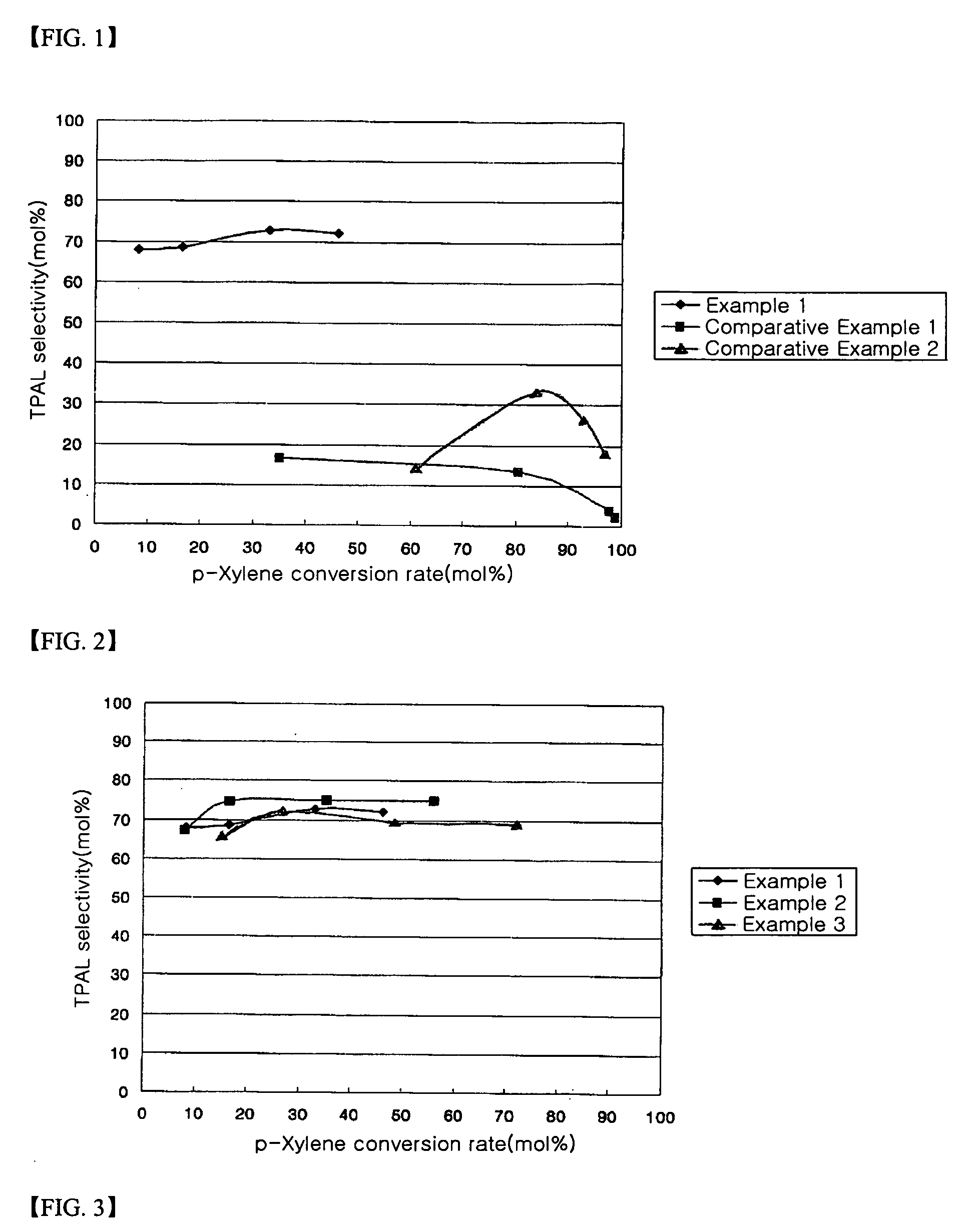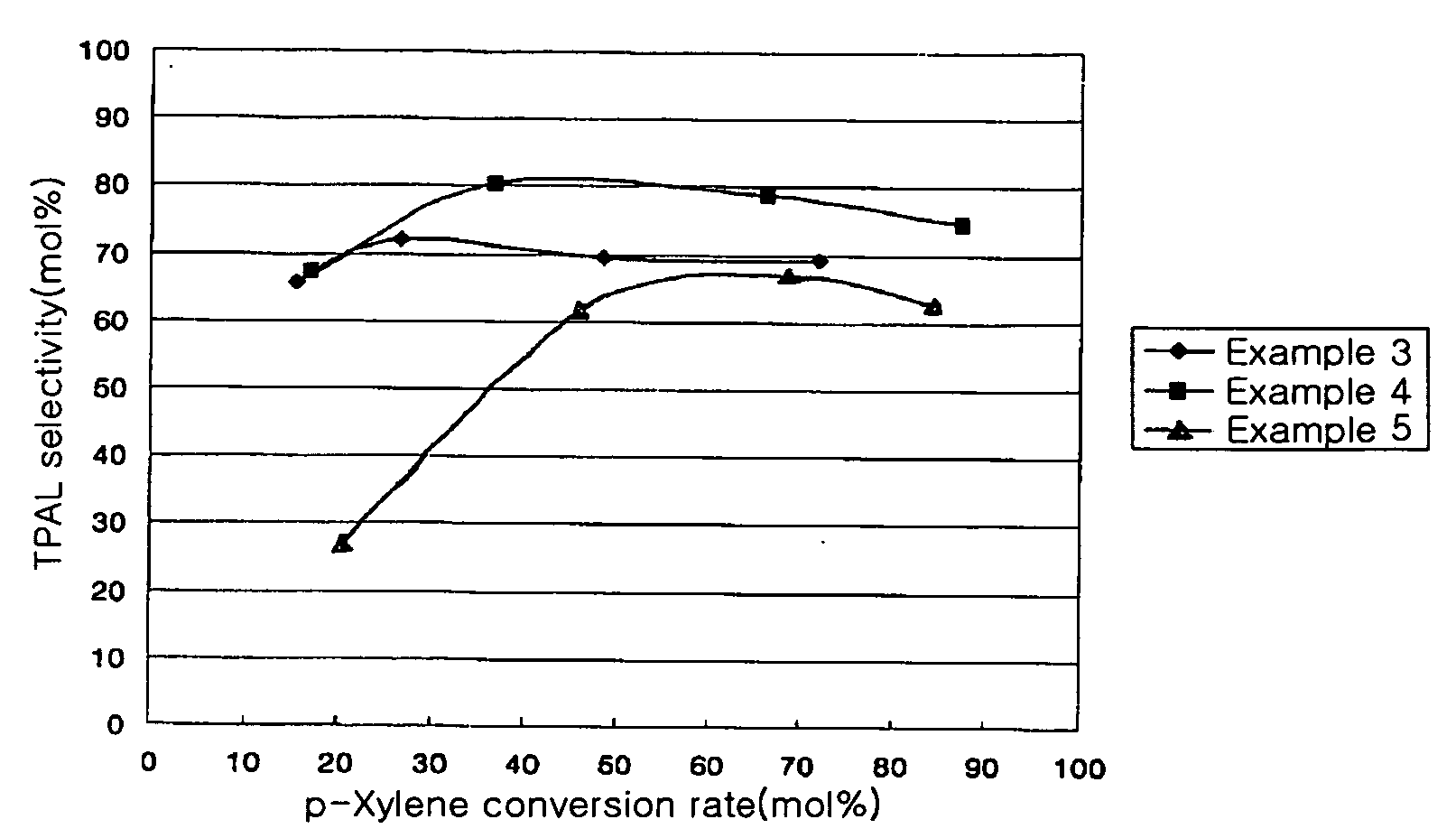Catalyst for partial oxidation of methylbenzenes and method for producing aromatic aldehydes using the same
a technology of partial oxidation and catalyst, which is applied in the preparation of carbonyl compounds, physical/chemical process catalysts, metal/metal-oxide/metal-hydroxide catalysts, etc., can solve the problems of insufficient mass production of terephthalaldehyde, limited industrial use of catalysts, and difficult separation and purification, etc., to achieve uniform composition and capacity, good selectivity, and high yield
- Summary
- Abstract
- Description
- Claims
- Application Information
AI Technical Summary
Benefits of technology
Problems solved by technology
Method used
Image
Examples
example 1
[0039] An aqueous ammonium metatungstate solution was prepared to a concentration of 2 mmol / g as a tungsten source. 12.0 g of this solution was diluted with 60 mL of water. To the resultant solution was added 60 g of an α-alumina support SA5218 (Norton; 3 / 16-inch; spherical; surface area=0.008 m2 / g; pore size=75 μm) which had been pre-heated at 120° C. Evaporation drying was performed while stirring the solution. After drying at 120° C. for 18 hours, baking was performed under air atmosphere at 650° C. for 2 hours. The obtained catalyst had a composition of 6.4% WOx / SA5218.
[0040] 60 g of the catalyst was filled in a common continuous flow reactor. Reaction was performed under the following condition.
[0041] Reaction pressure: normal pressure
[0042] Reactant gas composition (volume ratio): p-xylene / oxygen / nitrogen=0.25 / 6.25 / 93.5 (oxygen / p-xylene=25)
[0043] Reactant gas feed rate: 1.2 L / min
[0044] Space velocity (GHSV): 1500 hr−1
[0045] Reaction temperature: 450, 500, 550, 580° C.
[0...
example 2
[0051] A catalyst was prepared in the same manner of Example 1 using 18.0 g of an aqueous ammonium metatungstate solution. A catalyst having a composition of 9.3 wt % WOx / SA5218 was obtained. Reaction results are given in Table 2 and FIG. 2.
example 3
[0052] A catalyst prepared in the same manner of Example 1 using 36.0 g of an aqueous ammonium metatungstate solution. A catalyst having a composition of 17.8 wt %. WOx / SA5218 was obtained. Reaction results are given in Table 2 and FIG. 2.
TABLE 2ReactionCon-temper-versionSelectivityOne-pass yieldClassi-aturerate(mol %)(mol %)fication(° C.)(mol %)TPALPTALTPALPTALExample 24508.067.23.35.40.350016.474.83.612.30.655035.175.13.726.41.358055.975.13.742.02.1Example 345015.365.74.210.10.650026.772.24.219.31.155048.569.74.533.82.258072.069.24.149.83.0
TPAL: terephthalaldehyde,
PTAL: p-tolualdehyde
[0053] As seen in Table 2 and FIG. 2, the catalytic activity increased as the supporting amount increased. Particularly, when the catalyst supporting amount was 17.8 wt % (Example 3), the conversion rate increased to 72%, which is much higher than Examples 1 and 2, in which the catalyst supporting amount was 6.4 wt % and 9.3 wt %, respectively. The selectivity was also very superior, in the range ...
PUM
| Property | Measurement | Unit |
|---|---|---|
| Pore size | aaaaa | aaaaa |
| Specific surface area | aaaaa | aaaaa |
| Temperature | aaaaa | aaaaa |
Abstract
Description
Claims
Application Information
 Login to View More
Login to View More - R&D
- Intellectual Property
- Life Sciences
- Materials
- Tech Scout
- Unparalleled Data Quality
- Higher Quality Content
- 60% Fewer Hallucinations
Browse by: Latest US Patents, China's latest patents, Technical Efficacy Thesaurus, Application Domain, Technology Topic, Popular Technical Reports.
© 2025 PatSnap. All rights reserved.Legal|Privacy policy|Modern Slavery Act Transparency Statement|Sitemap|About US| Contact US: help@patsnap.com


